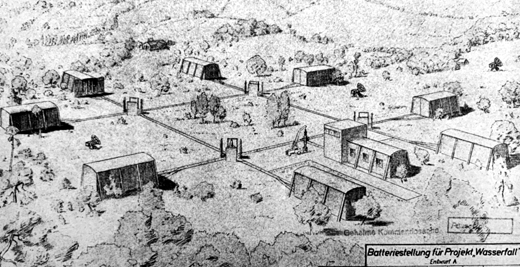
Wasserfall: German anti-aircraft guided missile

Wasserfall when placed on the launch pad. The location and time of the photo shoot are unknown.
Work on Wasserfall was carried out in 1941-1945 at the research center in Peenemünde under the direction of Wernher von Braun. The project was based on previous experience in creating the V-2 ballistic missile. Wasserfall, as one of the wunderwaffes created in the Third Reich, was supposed to, along with other developed representatives of this class of weapons, "sweep" the Allied heavy bombers from the German sky. But did the Allies really have anything to fear?
Wasserfall is included in the so-called Miraculous weapon of Hitler, which was supposed to reverse the unfavorable course of events on the fronts of World War II, which since 1943 took place on land, at sea and in the air, in favor of the Third Reich. Such categorization had a negative impact on its general image in the literature, which can be found in a large number of publications. This missile was sometimes credited with fantastic performance characteristics, which it simply could not have in view of the level of development of technology at that time, there were reports of aircraft shot down with its participation, or there were reports of development options that German engineers never built and did not appear anywhere .They're even on drawing boards. Therefore, it was concluded that, despite the popular science nature of the article, the reader should familiarize himself with the list of the most important bibliographic units used when working on the text.

View of the Type I launch pad for Wasserfall missiles. As you can see, they were supposed to be stored in wooden buildings, from where they were transported to the launch pads.
The German archives dedicated to the Wasserfall rocket are relatively numerous, especially compared to most other weapons bearing the Wunderwaffe name. Until today, at least four folders with 54 pages of documents have been preserved in German archives and museums, 31 of which are drawings and photographic documentation, including detailed steering wheels, views of the engine compartment, drawings of fuel tanks and fuel system diagrams. The remaining documents, also enriched with a number of photographs, are supplemented by more or less extensive technical descriptions of the structural elements mentioned in the previous sentence and calculations. In addition, there are at least eight reports containing information about the aerodynamics of the projectile.
Using the aforementioned German reports, after the end of the war, the Americans prepared a translation of them, thanks to which, for the purposes of research carried out in domestic defense enterprises, they created at least two fairly extensive documents on Wasserfall (and more specifically on model tests): Tests in a wind tunnel to find out Influence of Speed and Center of Gravity on Handling C2/E2 Design Wasserfall (February 8, 1946) translated by Hermann Schoenen and Aerodynamic Design Of The Flak Rocket, translated by A. H. Fox. In May 1946, in the United States, the Publications Division of the Aviation Staff published a collective publication called Technical Intelligence. An addendum including, among other things, interesting information confirming that the scientists working at Peenemünde were working on a proximity fuse for the Wasserfall missile. This is quite interesting, because some specialists generally believe, despite confirmation from German sources, that this type of fuse was never intended for a projectile. However, the publication does not contain an indication of its title. According to Igor Witkowski's book ("Hitler's Unused Arsenal", Warsaw, 2015), Marabou could have been the fuse. A brief description of this device can be found in an article by Friedrich von Rautenfeld in a post-conference volume on the development of German guided missiles (Brunswick, 1957). It is worth noting that von Rautenfeld does not mention that the Marabou was to be equipped with any rocket built in the Third Reich.
